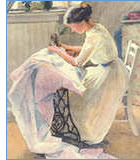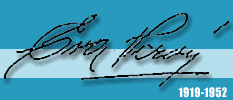As Néstor
Ferioli pointed out in his seminal work1 , La Fundación Eva Perón has two parallel histories, one
official and one unofficial. The official trajectory of the Fundación
can be found in legal documents, archives, newspapers and books. The unofficial
history of the Fundación has entered into the realm of folklore,
both Peronista and antiPeronista.
 The
deepest roots of the Fundación can be found in Evita’s childhood
when she learned from her mother to reach out to those in need. Evita
was a mirror image of Doña Juana, a widow who sewed day and night
to support her five children, yet never turned down their requests for
a few coins or a hot tea to help those for whom no safety net existed. The
deepest roots of the Fundación can be found in Evita’s childhood
when she learned from her mother to reach out to those in need. Evita
was a mirror image of Doña Juana, a widow who sewed day and night
to support her five children, yet never turned down their requests for
a few coins or a hot tea to help those for whom no safety net existed.
In the small pampas towns of Los Toldos and Junín where she grew
up, Evita met the homeless (El Señor “Buendía”
who lived in the hedgerows but always greeted her with a cheerful “Buendía,
mi hija”), the mentally ill (la Mujer del Niño Muerto who
year after year asked for money to bury her dead child), and people with
disabilities (Doña Asunción who applauded from her wheelchair
Evita’s acrobatic attempts to make her laugh)2 .
She was to continue to meet their counterparts throughout her life and
especially after Perón’s inauguration as President on June
4, 1946.
From the very beginning in the Secretaría de Trabajo y Previsión
where he had worked as Secretary of Labor from 1943-1945, Perón
had established a direct personal relationship with those who recurred
to him: Perón-People. He personally met with not only union leaders
but with any individual worker who asked him for an audience.
 After
Perón’s inauguration as President, the workers lost and missed
their direct contact, their personal relationship with him. Although he
could no longer attend to them himself, the workers and the poor knew
where he lived and began to ring the doorbell of the Presidential Residence
in Buenos Aires3.
Evita had already decided that she would not be a traditional First Lady
(a title that Jacqueline Kennedy said sounded like the name of a horse);
she began to find ways to meet the needs of the people who crowded the
sidewalks outside her house. After
Perón’s inauguration as President, the workers lost and missed
their direct contact, their personal relationship with him. Although he
could no longer attend to them himself, the workers and the poor knew
where he lived and began to ring the doorbell of the Presidential Residence
in Buenos Aires3.
Evita had already decided that she would not be a traditional First Lady
(a title that Jacqueline Kennedy said sounded like the name of a horse);
she began to find ways to meet the needs of the people who crowded the
sidewalks outside her house.
By September the mail averaged 3,000 letters a day and long lines of mothers
with babies in their arms and toddlers clutching at their skirts, of older
people and people with disabilities, the forgotten and forsaken of society,
daily converged on the Residence. Evita knew she had to find a way to
offer them immediate help. She began to buy food and clothing with her
own money and stack the boxes and bundles in an unused garage on the Residence
property. When the labor unions found out, they began to send contributions
- everything from shoes to sugar.
After Perón went to bed at night, Evita, her private secretary,
Atilio Renzi, her maid, Irma Ferrari, the cook, Bartolo, and two waiters,
Sánchez and Fernández, would work until dawn to package
the merchandise. One day Perón visited the garage, and was surprised
to find that all the items were brand new.
“Of course,” Evita replied. “I’m buying some things
with my own money and some are donated by people who want to help.”
“Well, this is a real delight for the needy! “(“Es una
verdadera delicia para los necesitados!”) exclaimed Perón,
and from then on the garage was known as “La Tienda de las Delicias”
or “The Store of Delights.”
In his book, Del Poder al Exilio,4 Perón reminisced about the official beginning of the Fundación
Eva Peron:
“One night at the dinner table, [Evita] explained her program. She
sounded like a calculator.
I asked her, ‘And the money?’
She looked at me in amusement. ‘That’s easy,” she replied.
“I’ll start with yours.’
‘With mine? What money of mine?’
‘Your salary as President.’ ”
 On
a spring day in September of 1946, when the scent of the jacaranda filled
the air around Plaza de Mayo, Evita began to meet people in the same office
Perón had once occupied as Labor Secretary5.
Hoping to fill the vacuum his absence had created, she kept to the same
open door policy; both workers and “descamisados” knew where
to find her when they needed her. On
a spring day in September of 1946, when the scent of the jacaranda filled
the air around Plaza de Mayo, Evita began to meet people in the same office
Perón had once occupied as Labor Secretary5.
Hoping to fill the vacuum his absence had created, she kept to the same
open door policy; both workers and “descamisados” knew where
to find her when they needed her.
Even though Evita never took “time off” to sit down and formally
design an organization that would meet the many and varied needs of the
people who came to her with their problems, she did realize that soon
she would require more hands and minds, more structure and more space
than were readily available. The people who looked to her with faces full
of trust had long lived with no safety net for health care or housing;
the price to be paid for years of neglect would be high; the personal
price higher than she could ever have imagined at the time.
In 1947, Evita went to Europe with the idea that Europe would teach her
how to meet the needs of the most destitute of her country. What she discovered
in the war-ravaged Old World disillusioned her. Most of the institutions
she visited had been created by the state or by the wealthy... “and
the rich, when they think of the poor, think poorly.”6 Evita came back from Europe with the goal of thinking richly, of creating
works that the rich would design for themselves, would consider good enough
for their children to live in, learn in, play in, and be sick in. And
she succeeded.
On June 19, 1948, degree number 220.564 established the María Eva
Duarte Social Help Foundation ( In 1950, this name was simplified into
the Fundación Eva Perón, the Eva Perón Foundation,
just as the bouffant hairstyles and big hats of the ‘40’s streamlined
into the elegant chignons and tailored suits of the ‘50’s).
The Foundation had five goals, summarized here:
 1.
To loan money, provide tools, establish scholarships for deserving people
who lack resources. 1.
To loan money, provide tools, establish scholarships for deserving people
who lack resources.
2. Construct housing for needy families.
3. Construct educational establishments, hospitals, recreational facilities
and / or any other edifice which the Foundation considers necessary.
4. Construct buildings for the common good which can be transferred with
or without charge to National, Provincial or Municipal governments.
5. Contribute or collaborate by any means available to the realization
of works constructed for the common good and which help meet the basic
needs of the least favored social classes.
Even though she had teased him about it, Evita did not make use of Perón’s
salary; she used $10,000 pesos of her own money as the Foundation’s
first patrimony.
Nestor Ferioli points out that
“Evita constructed the Foundation rapidly, in the same way that she
would later organize the Peronista Women’s Party [el Partido Peronista
Feminino]. She thought it best so as to be able to work quickly to have
a verticalist, pyramid structure which gave her absolute freedom to make
decisions and enabled her to escape from the bureaucracy she so detested.
That is why people say that Evita wouldn’t tolerate “second
fiddles” around her. That is also why the Foundation did not have
any irrelevant rules or administrators until 1953 [after Evita’s
death].” 7
From its beginnings in an unused garage to its destruction in 1955 at
the hands of those who, when they think of the poor, think poorly, the
Foundation played an almost magical part in Argentine history; it was
an anchor, a harbor, a door which opened when all other doors had been
slammed shut. Many people in Argentina today wish they could find the
key to open that door and be comforted by the face on the other side of
it.
1 Nestor
Ferioli, La Fundación Eva Peron/ 1, Centro
Editor de America Latina, 1990.
2 Erminda Duarte, Mi Hermana Evita, Centro de Estudios Eva Peron,
1973.
3 The President of Argentina works in Government House, the Pink House “la
Casa Rosada”.Perón and Evita lived in the Presidential Residence,
the “Palacio Unzue”. Because Perón and Evita had lived
there, and Evita had died there, the mansion was razed by the military
after the 1955 Coup d’Etat which overthrew Perón. At present,
the National Library occupies the site.
4 Juan Perón: Del Poder al Exilio , p.72.
5 This beautiful building graced with a clocktower is now the Consejo de
Deliberante.
6 Eva Peron, La Razon de Mi Vida, p. 180
7 Ferioli, op.cit., p. 36 |





